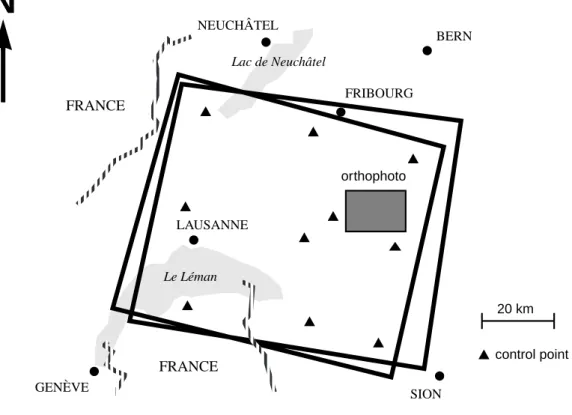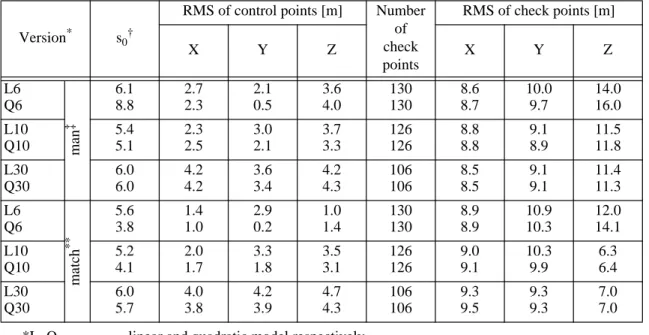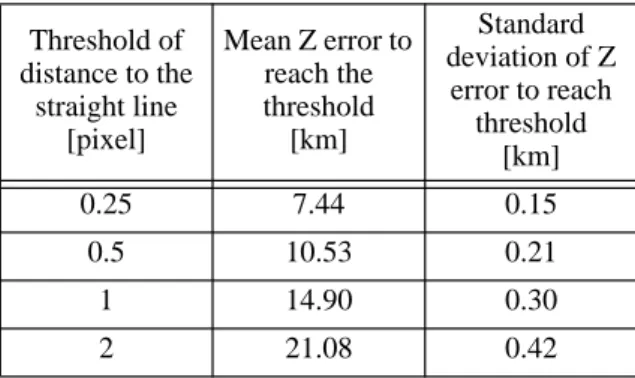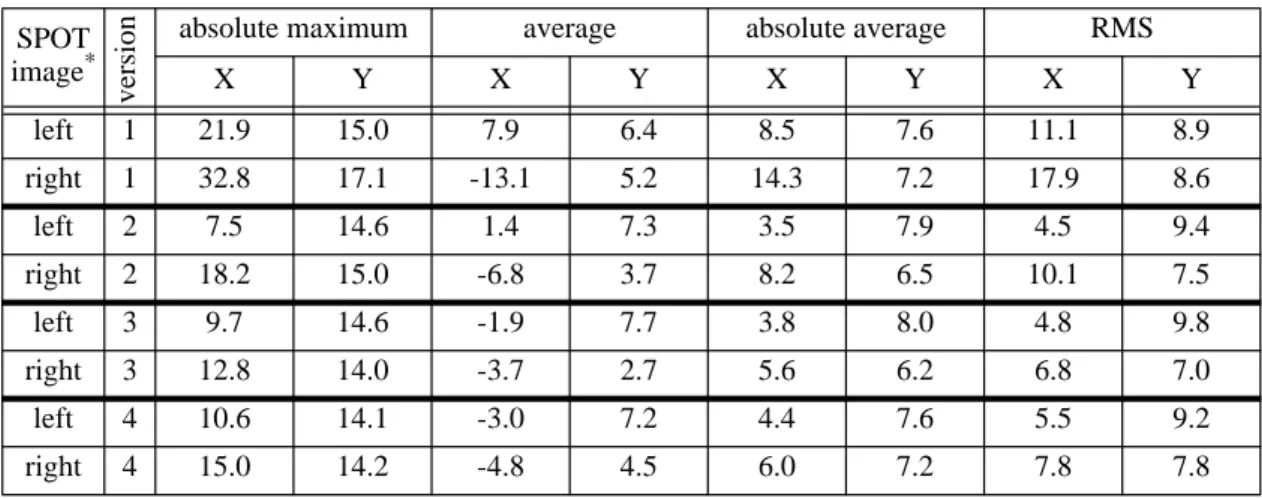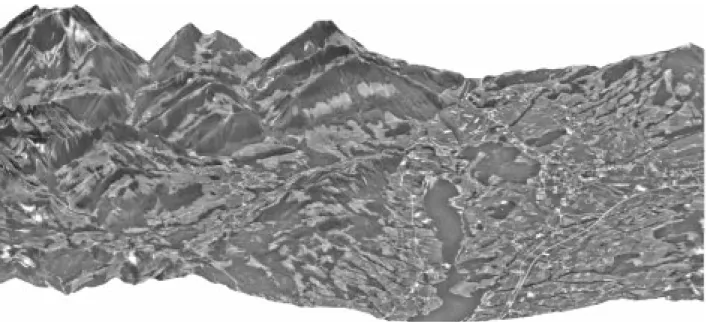Research Collection
Conference Paper
Metric information extraction from spot images and the role of polynomial mapping functions
Author(s):
Baltsavias, Emmanuel P.; Stallmann, Dirk Publication Date:
1992
Permanent Link:
https://doi.org/10.3929/ethz-a-004336038
Rights / License:
In Copyright - Non-Commercial Use Permitted
This page was generated automatically upon download from the ETH Zurich Research Collection. For more information please consult the Terms of use.
ETH Library
METRIC INFORMATION EXTRACTION FROM SPOT IMAGES AND THE ROLE OF POLYNOMIAL MAPPING FUNCTIONS
Emmanuel P. Baltsavias, Dirk Stallmann Institute of Geodesy and Photogrammetry
Swiss Federal Institute of Technology ETH-Hoenggerberg, CH-8093 Zurich, Switzerland
Tel.: +41-1-3773042, Fax: +41-1-3720438, e-mail: manos@p.igp.ethz.ch Commission IV
ABSTRACT
This paper handles the aspect of metric information extraction from SPOT images and focuses mainly on sensor modelling and the geometric accuracy potential of polynomial mapping functions, and secondly on the use of these functions for automated derivation of DTMs and generation of digital orthophotos.
The sensor modelling is based on V. Kratky’s strict geometrical model. First, an accuracy analysis is provided based on points of varying definition quality covering the whole image format and having a height range of 1700 m. Different computation versions and an accuracy comparison is presented. Kratky also provides polynomial mapping functions to transform from image to image, object to image, and image to object space. The mapping functions are much faster, easier to implement, and almost equally accurate as compared to strict transformations. The accuracy of these functions will be assessed. This is crucial, since these polynomial functions are subsequently used for automatic DTM and orthophoto generation.
The automatic DTM generation is based on a modified version of the Multiphoto Geometrically Constrained Matching (MPGC). The polynomial functions for the image to image transformation are used to define geometric constraints in image space. Thus, the search space is reduced along almost straight epipolar lines and the success rate and reliability of matching increase. The deviation of the epipolar lines from straight lines will be analysed for different image positions, heights and height approximations. The generation of digital orthophotos is fully automated and is based on polynomial functions modelling the object to image transformation. Aspects regarding speed and accuracy will be analysed.
KEY WORDS: remote sensing, SPOT, geometrical accuracy, constrained matching, DEM, orthophoto 1. INTRODUCTION
SPOT data is extensively used because of its geometric resolution and secured availability, and the stereo capability of the sensor. This data can supply substantial topographic and thematic information to GIS. Today, problems exist firstly in the extraction of the appropriate information from satellite images, especially in an automated manner, and secondly in the integration of this information into GIS. The geometric accuracy of SPOT has been extensively investigated during the last years.
Different models of varying complexity, rigour and accuracy have been developed (Kratky, 1989a; Westin, 1990; Konecny et al., 1987; Toutin, 1985, Gugan, 1987) up to SPOT block adjustment (Veillet, 1990). Various tests have proven that the geometric accuracy potential of SPOT is below 10 m in both planimetry and height.
However, strict transformations from image to image, o b j e c t t o i m a g e , a n d i m a g e t o o b j e c t s p a c e a r e computationally very intensive and pose problems on the implementation of real-time positioning in analytical photogrammetric instruments. Kratky, 1989b, proposed the use of polynomial mapping functions (PMFs) that are much faster and almost equally accurate (maximum error less than 1 m in object and 1µm in image space) as compared to the strict transformations. The aim of this
paper is to test the geometric accuracy of PMFs and c h e c k t h e i r u s e f u l n e s s f o r a u t o m a t e d D T M a n d orthophoto generation. Since the PMFs are derived using the results of the strict SPOT model, their accuracy d e p e n d s o n t h e a c c u r a c y o f t h e l a t t e r . T h u s , investigations on the accuracy of Kratky’s strict model and ways to improve it will also be presented.
2. KRATKY’S SPOT MODEL
Kratky’s model processes single and stereo panchromatic level 1A and 1B SPOT images. It is an extended bundle formulation considering in a rigorous way all physical aspects of satellite orbiting and of earth imaging, together with geometric conditions of the time-dependent intersection of corresponding imaging rays in the model space. The ephemeris data (position and attitude) are not necessary but they may be used optionally. Orbital perturbations are taken into account by allowing the SPOT orbital segment to be shifted with respect to its expected nominal position. The total number of unknowns per image is 14 - 6 elements of exterior orientation, linear and quadratic rates of change for the rotation angles, a change for the camera constant, and a quadratic distortion in x (corresponding to a shift of the principal point along the CCD sensor). The quadratic
∆f
Proc. of 17th ISPRS Congress, 2. - 14. August, Washington D.C., USA. In IAPRS, Vol. 29, Part B4, pp. 358 - 364
rates may be dropped (linear model). Six weighted constraints keep the orbital positions of the two sensors within statistical limits from the expected nominal orbits or the ephemeris data. Twelve absolute constraints are enforced in order to keep projection centres moving strictly along appropriate elliptical orbital segments.
Thus, linear and quadratic rates of change in X, Y, Z, which are eventually used as given values, are calculated.
The minimum number of full control points is 4 for the linear model of attitude changes and 6 for the quadratic.
3. TEST DATA
A stereo SPOT panchromatic level 1A model over W.
Switzerland was acquired (Figure 1). The inclination of the sensor’s optical axis was 23.4˚ R and 19.2˚ L respectively, leading to a B/H ratio of ca. 0.8. The acquisition dates were 20.7.1988 and 27.8.1988 with significant radiometric differences between the two images, particularly in agricultural areas. The elevation range was 350 - 3000 m. The following preprocessing was applied to the original digital images:
● reduction of periodic and chess pattern noise
● Wallis filtering for contrast enhancement
● Wallis filtering for edge enhancement (optional) 136 points of good to very poor definition covering the whole image format and with a height range of 350 -
2100 m were used as control and check points. They were measured with an accuracy of approx. 5 m in 1:25,000 topographic maps. Their pixel coordinates were measured in one image manually, and in the second (a) manually, and (b) with least squares template matching using the first image as reference. The following versions were computed with Kratky’s model:
(a) linear versus quadratic rates of change for the rota- tion angles
(b) 6, 10, and 30 control points
(c) pixel coordinates of second image determined manually versus through matching
The results (without exclusion of any point) are listed in Table 1.
The linear and quadratic models give similar results. This was the case in previous investigations too. The quadratic model gives slightly better results in Y, but worse results in Z with 6 control points. There is a big improvement in Z from 6 to 10 control points but no improvement from 10 to 30 points. There is an large improvement in Z when the pixel coordinates in the second image are measured by matching. For the 10 control point version, the manual measurements lead to a by 85% worse RMS in Z as compared to the matching measurements! Version linear, 10 control points, matching measurements was selected for the further work.
20 km LAUSANNE
orthophoto NEUCHÂTEL
FRIBOURG
Figure 1 SPOT stereo model with 10 control points. The test region for orthophoto generation (map sheet 1225) is also marked.
control point Lac de Neuchâtel
BERN
Le Léman
GENÈVE SION
N
FRANCE
FRANCE
Table 1 Precision and accuracy measures for Kratky’s SPOT model using different versions
Version*
*L, Q ... linear and quadratic model respectively s0†
†s0... a posteriori standard deviation of unit weight RMS of control points [m] Number
of check points
RMS of check points [m]
X Y Z X Y Z
L6 Q6
man‡
‡man ... pixel coordinates in second image measured manually 6.1
8.8
2.7 2.3
2.1 0.5
3.6 4.0
130 130
8.6 8.7
10.0 9.7
14.0 16.0 L10
Q10
5.4 5.1
2.3 2.5
3.0 2.1
3.7 3.3
126 126
8.8 8.8
9.1 8.9
11.5 11.8 L30
Q30
6.0 6.0
4.2 4.2
3.6 3.4
4.2 4.3
106 106
8.5 8.5
9.1 9.1
11.4 11.3 L6
Q6
match**
**match... pixel coordinates in second image measured by least squares matching 5.6
3.8
1.4 1.0
2.9 0.2
1.0 1.4
130 130
8.9 8.9
10.9 10.3
12.0 14.1 L10
Q10
5.2 4.1
2.0 1.7
3.3 1.8
3.5 3.1
126 126
9.0 9.1
10.3 9.9
6.3 6.4 L30
Q30
6.0 5.7
4.0 3.8
4.2 3.9
4.7 4.3
106 106
9.3 9.5
9.3 9.3
7.0 7.0
4. FAST POLYNOMIAL MAPPING FUNCTIONS
After the strict SPOT model is estimated the PMFs are derived by the following approach (Figure 2). A 5 x 5 regular grid is defined in the left image. By using the results of the rigorous solution and three heights (the minimum and maximum of the scene, and their average), map coordinates for 75 object points are computed.
These are projected in the right image again using the rigorous solution. By using the known coordinates in all three spaces, the coefficients of polynomial functions to map from image to image, image to object, and object to image space (in both directions, i.e. 6 polynomials altogether) are computed by least squares adjustment.
Thereby, the object space is reduced to two dimensions by extracting the elevation, i.e. Z is an independent parameter connecting all three spaces. One polynomial is computed for each coordinate to be determined, and for the mappings involving the object space separate polynomials are determined for left and right image. The degree of the transformation, the number and the form of needed terms were determined experimentally. The degree of the polynomials is 3 - 4 with 11 - 16 terms.
K r a t k y p r o v i d e s f o r e a c h m a p p i n g t w o s e t s o f polynomials, a basic and an extended. The extended has two more terms involving mainly powers of y or Y. It should be used if the quadratic model was used in the rigorous solution. If the linear model was used, then the basic polynomials suffice. A similar, although less accurate, approach with five, instead of three, heights is also used by the algorithm of the company TRIFID w h i c h i s i n t e g r a t e d i n t h e I n t e r g r a p h D i g i t a l
Photogrammetric Station 6287 for SPOT modelling and digital orthophoto generation.
In our tests the PMFs (basic model) were determined after the previously mentioned rigorous solution with the linear model, 10 control points and the matching measurements. The pixel and object coordinates of the 136 points were determined by the PMFs and compared to their known values. The differences did not exceed 1 m in object and 1µm in image space, thus verifying Kratky’s results. The accuracy of PMFs was also tested by another method. By using the image to image PMFs a n d t h r e e o u t o f t h e f o u r p i x e l c o o r d i n a t e s of each point, the heights can be determined and compared to the known values. This was d o n e f o r t h e t r i p l e t s , ,
, . The last two cases gave RMS errors of ca. 135 m, which is not surprising since the image base is approximately in the x direction. The first two cases gave the same RMS of 6.2 m which is identical to the results of the rigorous solution.
Having established that the PMFs are fast and accurate enough the next step was their integration in image matching for DTM generation.
5. MODIFIED MPGC USING PMFs FOR AUTOMATIC DTM GENERATION Automatic DTM generation from SPOT images has been extensively pursued and is particularly attractive for poorly mapped countries. Many algorithms have been developed but none exploits geometric information from the SPOT sensor to guide and support the matching. A
x' y' x'' y'', , ,
( )
x' y' x'', ,
( ) (x'' y'' x', , ) x' y' y'', ,
( ) (x'' y'' y', , )
image 1
object space
image 2
E = F(x’,y’,h) N = F(x’,y’,h)
x” = F(x’,y’,h) y” = F(x’,y’,h)
x’ = F(x”,y”,h) y’ = F(x”,y”,h)
x”= F(E,N,h) y”= F(E,N,h) E = F(x”,y”,h)
N = F(x”,y”,h) x’= F(E,N,h)
y’= F(E,N,h)
Zmax
Zmin (Zmin + Zmax) / 2
Figure 2 Derivation of fast polynomial mapping functions
reason for that is the fact that the SPOT sensor is linear and thus the perspective relations are valid only within an image line. It was often stated that the epipolar geometry does not exist for SPOT images and that resampling to epipolar images requires a DTM. However, strictly speaking the epipolar geometry does not even exist for frame cameras (which is why most bundle adjustment programs use additional parameters). So, the aim of our investigations was to check to what extent by using K r a t k y ’ s P M F s a n e p i p o l a r g e o m e t r y c o u l d b e established.
To check that, the following approach was used. A height error
∆
Z (two versions;∆
Z = 50 m and 100 m) was added and subtracted to the known heights of the 136 points. For each point, these two erroneous heights and the image to image PMFs were used to transform the pixel coordinates of the left image in two points in the right image. They defined a straight line which passed through the known correct pixel coordinates of the point.The question that had to be answered was whether by arbitrarily changing the height, the projection by using PMFs of the left point in the right image would fall on this straight line, i.e. whether this straight line was the epipolar line (Figure 3). Thus, the known height was sequentially incremented by 25 m in positive and negative direction (leading to object points like Pnin Figure 3), and the projection of the left point in the right image and its distance from the straight line were computed. This distance is a measure of deviation from straight epipolar lines. The results for all 136 points are listed in Table 2. The results are identical for both versions of
∆
Z, and for positive and negative increments.As it can be seen from the table a deviation of 0.25 pixels is reached only with a height error of over 7 km! Since such errors are impossible, even more for matching
which requires good approximations in order to be successful, straight epipolar lines can be assumed.
The above knowledge was used to modify the Multiphoto Geometrically Constrained Matching (Baltsavias, 1992) for automatic DTM generation. The points to be matched were selected in one of the two images (reference image).
For each point, by using a height approximation and an error
∆
Z as above, the epipolar line in the other image was determined. If only approximations for the pixel coordinates exist, then a height approximation can be derived by the image to image PMFs from the pixel coordinates of the point in the reference image and the x pixel coordinate in the other image. Weighted geometric c o n s t r a i n t s f o r c e t h e m a t c h i n g t o s e a r c h f o r a corresponding point only along the epipolar line. This reduction of the search space from 2-D to 1-D increases the success rate and reliability of the matching results.Table 2 Deviations from a straight epipolar line for different height errors
Threshold of distance to the
straight line [pixel]
Mean Z error to reach the threshold
[km]
Standard deviation of Z
error to reach threshold
[km]
0.25 7.44 0.15
0.5 10.53 0.21
1 14.90 0.30
2 21.08 0.42
Additionally, less iterations are required and the DTM production time is decreased. More details on this matching approach and extended tests are published in Baltsavias and Stallmann, 1992.
6. DIGITAL ORTHOPHOTO GENERATION The object to image PMFs were used to transform a DTM into SPOT images for orthophoto generation. The PMFs, while being very accurate, offer tremendous advantages regarding speed, a crucial factor for orthophoto production. The speed can be further increased by suitable factorisation. As an example let’s consider the basic object to image polynomial
(1) with
, (2)
(3) involving 30 multiplications and 13 additions. By a suitable factorisation its form changes to
(4)
involving 14 multiplications and 13 additions. Even larger computational savings can be achieved by using incremental updating of the results of the previous pixel within the column (or row). Updating in column direction is faster than row updating as there are less terms involving N than E. The first pixel of each column can be updated from the results of the first or last pixel of the previous column. The implementation of this approach involves 5 multiplications and 8 additions, and for the first pixel of the columns 7 multiplications and 14 additions. The respective number for the extended PMFs is 5 multiplications and 9 additions, and 8 multiplications and 16 additions. A speed increase of factor 3 in comparison to equation (4) has been achieved. An orthophoto of a whole SPOT scene, using bilinear interpolation, needs only 15 min. on a Sparcstation 2.
This is faster than other much more expensive digital orthophoto systems that utilise special hardware (the PRI2SM workstation of I2S for example needs 20 min.).
The accuracy of the orthophotos produced by the PMFs is very good. In Baltsavias et al., 1991 accuracies (RMS) of 5 m - 6 m are reported. Hammon, Jensen, Wallen and Assoc., a California based company that has integrated our software within ARC/INFO, made tests with 8 SPOT scenes having big height ranges (up to 60 m - 4200 m).
F E N h( , , ) = aTp
aT = (1 h E N hE hN E2 EN N2 hE2 E3 E2N h2EN hE) pT = (p1 p2 … p14)
p1+h p( 2+Ep5+Np6)
E p( 3+E p( 7+hp10+Ep11+Np12)) +
N p( 4+Np9+E p( 8+h hp( 13+Np14))) +
P”n
possible deviation form straight (“epipolar”) line P”i
Yi
P’i
Pi
X Y
base
Zi + ∆Z
Pn Zi − ∆Z
O’ O”
Z
Figure 3 Approximation of epipolar geometry for SPOT images Xi Zi
reference image
reference image ray
straight (“epipolar”) line
epipolar plane
For the orthophoto production the USGS 30 m DTM was used. The accuracy (RMS) was within 40 ft, and for some scenes less than 30 ft, against the USGS 7.5 min.
topographic map.
Digital orthophotos were also produced with the above mentioned SPOT data in W. Switzerland (Figure 4). The 25 m Swiss DTM of the 1:25,000 map sheet 1225 (see Figure 1) having an RMS accuracy of 4.1 m and covering an area of 17.5 x 12 km was used for the orthophoto generation. The height range was 680 m - 2150 m.
Orthophotos were produced using both images of the stereo pair and four different versions. In all orthophotos the orthophoto pixel spacing was 8.333 m and the interpolation bilinear. The implementation of the PMFs was either by the incremental approach (fast version) or by using equation (4) (slow version).
Version 1: DTM densification by factor 3, projection using basic PMFs (from linear model), fast
Version 2: DTM projection with basic PMFs (linear model), threefold densification of anchor points, fast Version 3: like version 1 but slow
Version 4: like version 3 but using extended PMFs from quadratic model
A version like version 3 but with extended PMFs from the linear model gave the same results as version 3. A version like version 4 but with anchor point densification instead DTM densification gave the same results as version 4.
The accuracy of the orthophotos were tested in two ways.
The first test was a relative (inner) accuracy test comparing the orthophotos of the same version from the two SPOT images. Corresponding points should ideally have the same pixel coordinates. By using template matching the actual parallaxes (i.e. planimetric map coordinate differences) were detected. Version 1 showed increasing parallaxes of up to many pixels (mainly in x) while moving from left to the right part of the orthophoto.
V e r s i o n 2 s h o w e d a s i m i l a r b e h a v i o u r b u t l e s s pronounced. Versions 3 and 4 showed a very good
(subpixel) closure between left and right orthophoto, whereby version 4 was slightly superior in y. The reason for this behaviour lies in rounding errors that in the case of the incremental approach are accumulating. Since the processing starts from the top left corner and proceeds columnwise, it is clear that the errors for versions 1 and 2 increase in the right part of the orthophoto. This increase is enhanced by the fact that the heights are larger in the right part of the image. Version 2 gives better results than version 1 (and it is also faster) because less DTM points (by a factor 9) are transformed with the PMFs and thus less errors are accumulated. The errors are larger in x than in y because the PMF coefficients in x are larger than in y. To reduce these errors (a) double precision variables should be used (which was the case in the current implementation; however, the heights and the X, Y coordinates of the DTM origin are 4-byte real variables), and (b) the first pixel of each column should be computed by using equation (4). Thus, errors can accumulate only within one column. By computing strictly (i.e. by equation (4)) the pixel coordinates of not the first but the middle line of the orthophoto, the accumulation of errors within one column can be reduced to half its length. If these precautions are not met and the optimal accuracy is sought for, then the slow version should be used. In this case it is irrelevant whether DTM or anchor point densification is used, but the latter should be preferred as it is faster.
The second test checked the absolute accuracy and used 8 out of the 136 points that were imaged in these orthophotos. Their known pixel coordinates were transferred from one of the SPOT images in the o r t h o p h o t o s t h r o u g h t e m p l a t e m a t c h i n g . T h u s , planimetric map coordinates were derived, the heights were bilinearly interpolated from the DTM, and these values were compared to the known values. The accuracy measures are listed in Table 3.
Table 3 Accuracy measures (differences) for different options of orthophoto generation SPOT
image*
*Orthophoto from left or right SPOT image
version
absolute maximum average absolute average RMS
X Y X Y X Y X Y
left 1 21.9 15.0 7.9 6.4 8.5 7.6 11.1 8.9
right 1 32.8 17.1 -13.1 5.2 14.3 7.2 17.9 8.6
left 2 7.5 14.6 1.4 7.3 3.5 7.9 4.5 9.4
right 2 18.2 15.0 -6.8 3.7 8.2 6.5 10.1 7.5
left 3 9.7 14.6 -1.9 7.7 3.8 8.0 4.8 9.8
right 3 12.8 14.0 -3.7 2.7 5.6 6.2 6.8 7.0
left 4 10.6 14.1 -3.0 7.2 4.4 7.6 5.5 9.2
right 4 15.0 14.2 -4.8 4.5 6.0 7.2 7.8 7.8
7. CONCLUSIONS
I t h a s b e e n s h o w n t h a t w i t h K r a t k y ’s s t r i c t photogrammetric model for SPOT images an accuracy of 9 - 10 m in planimetry and 6 m in elevation can be achieved. Remarkable is the improvement of the elevation accuracy though point transfer by least squares matching.
The PMFs are faster, equally accurate and easier to implement than the strict transformations. Consequently they are suitable for use in image matching and digital orthophoto generation.
A very good approximation of the epipolar line can be derived from the PMFs. The application of the SPOT geometry reduce the search space to 1-D thus increasing the success, reliability and speed of the image matching.
A orthophoto of one SPOT scene can be produced in only 15 min. to a subpixel accuracy (< 10 m). Attention should be paid to the accumulation of rounding errors when incremental updating is used.
8. ACKNOWLEDGEMENTS
The authors express their gratitude to the Bundesamt für Landestopographie, Bern, Switzerland for providing the SPOT images and DTM data.
9. REFERENCES
Baltsavias, E. P., 1992. Multiphoto Geometrically Con- strained Matching. Ph. D. Dissertation, Mitteilungen Nr.
49, Institute of Geodesy and Photogrammetry, ETH Zu- rich, 221 p.
Figure 4 Orthophoto of map sheet 1225 draped over the DTM (1.5x increased heights), seen from north under 60˚ zenith angle
Baltsavias, E. P., Gruen, A., Meister, M., 1991. DOW - A system for generation of digital orthophotos from aerial and SPOT images. In: Proc. of 12th Asian Conference on Remote Sensing, 30 October - 5 November, Singapore, Vol. II, H-1-1-1 - H-1-1-7.
Baltsavias, E. P., Stallmann, D., 1992. Advancement in matching of SPOT images by integration of sensor geom- etry and treatment of radiometric differences. In: Proc. of 17th ISPRS Congress, Commission IV, 2 - 14 August, Washington D. C., USA.
Gugan, D. J., 1987. Practical aspects of topographic map- ping from SPOT imagery. Photogrammetric Record, 12(69):349-355.
Konecny, G., Lohmann, P., Engel, H., Kruck, E., 1987.
Evaluation of SPOT imagery on analytical photogram- metric instruments. PERS, Vol. 53, No. 9, pp. 1223 - 1230.
Kratky, V., 1989a. Rigorous photogrammetric processing of SPOT images at CCM Canada. ISPRS Journal of Pho- togrammetry and Remote Sensing, Vol. 44, pp. 53 - 71.
Kratky, V., 1989b. On-line aspects of stereophotogrammet- ric processing of SPOT images. PERS, Vol. 55, No. 3, pp.
311 - 316.
Toutin, Th., 1985. Analyse mathématique des possibilités cartographiques du système SPOT. Doctoral thesis, Ecole Nationale des Sciences Géographiques, Paris.
Veillet, I., 1990. Block adjustment of SPOT images for large area topographic mapping. In: Int. Archives of Pho- togrammetry and Remote Sensing, Vol. 28, Part 3/2, pp.
926 - 935.
Westin, T., 1990. Precision rectification of SPOT imagery.
PERS, Vol. 56, No. 2, pp. 247 - 253.
